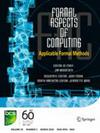Compositional Analysis of Probabilistic Timed Graph Transformation Systems
IF 1.4
4区 计算机科学
Q3 COMPUTER SCIENCE, SOFTWARE ENGINEERING
引用次数: 2
Abstract
The analysis of behavioral models is of high importance for cyber-physical systems, as the systems often encompass complex behavior based on, e.g., concurrent components with mutual exclusion or probabilistic failures on demand. The rule-based formalism of Probabilistic Timed Graph Transformation Systems (PTGTSs) is a suitable choice when the models representing states of the system can be understood as graphs and timed and probabilistic behavior is important. However, model checking PTGTSs is limited to systems with rather small state spaces. We present an approach for the analysis of large-scale systems modeled as PTGTSs by systematically decomposing their state spaces into manageable fragments. To obtain qualitative and quantitative analysis results for a large-scale system, we verify that results obtained for its fragments serve as overapproximations for the corresponding results of the large-scale system. Hence, our approach allows for the detection of violations of qualitative and quantitative safety properties for the large-scale system under analysis. We consider a running example in which shuttles drive on tracks of a large-scale topology and autonomously coordinate their local behavior with other shuttles nearby. For this running example, we verify that (a) shuttles can always make the expected forward progress using several properties, (b) shuttles never collide, and (c) shuttles are unlikely to execute emergency brakes in two scenarios. In our evaluation, we apply an implementation of our approach in the tool AutoGraph to our running example.概率定时图变换系统的组成分析
行为模型的分析对于网络物理系统非常重要,因为系统通常包含复杂的行为,例如,具有互斥的并发组件或按需概率故障。当表示系统状态的模型可以被理解为图形,并且时间和概率行为很重要时,基于规则的概率定时图变换系统(PTGTSs)是一种合适的选择。然而,模型检查PTGTSs仅限于具有较小状态空间的系统。我们提出了一种方法,通过系统地将它们的状态空间分解为可管理的片段,来分析作为PTGTSs建模的大型系统。为了获得大规模系统的定性和定量分析结果,我们验证了对其片段获得的结果可以作为大规模系统相应结果的过近似值。因此,我们的方法允许检测在分析的大规模系统的定性和定量安全属性的违反。我们考虑了一个运行的例子,其中班车在大规模拓扑的轨道上行驶,并自主地与附近的其他班车协调其局部行为。对于这个运行的例子,我们验证了(a)在两种情况下,穿梭车总是可以使用几个属性来实现预期的前进,(b)穿梭车永远不会碰撞,(c)穿梭车不太可能执行紧急刹车。在我们的评估中,我们将工具亲笔中方法的实现应用到我们正在运行的示例中。
本文章由计算机程序翻译,如有差异,请以英文原文为准。
求助全文
约1分钟内获得全文
求助全文
来源期刊

Formal Aspects of Computing
工程技术-计算机:软件工程
CiteScore
3.30
自引率
0.00%
发文量
17
审稿时长
>12 weeks
期刊介绍:
This journal aims to publish contributions at the junction of theory and practice. The objective is to disseminate applicable research. Thus new theoretical contributions are welcome where they are motivated by potential application; applications of existing formalisms are of interest if they show something novel about the approach or application.
In particular, the scope of Formal Aspects of Computing includes:
well-founded notations for the description of systems;
verifiable design methods;
elucidation of fundamental computational concepts;
approaches to fault-tolerant design;
theorem-proving support;
state-exploration tools;
formal underpinning of widely used notations and methods;
formal approaches to requirements analysis.
 求助内容:
求助内容: 应助结果提醒方式:
应助结果提醒方式:


